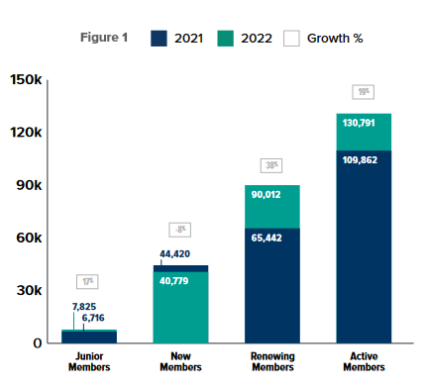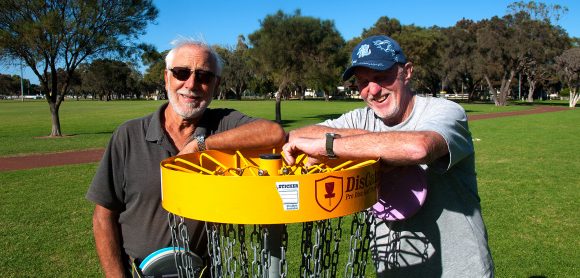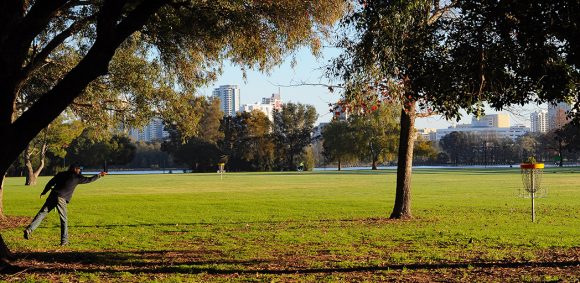The answer to this question lies within another question. Why is disc golf growing so fast? Internationally and within Australia, disc golf has been on a growth curve matched by few other sports or recreational pastimes.






Our game, one that can be just as readily played casually in a park or on a professionally designed, championship-level course – seems to have caught the zeitgeist in how society wants to recreate. Here are what we see as the reasons.
Reason One – Disc Golf Is Accessible

Pictured here is a golf disc. You can carry more, but you only need one to play a round. It is the result of many years of evolution in design and plastics technology. Feedback from champion players, scientific testing and sixty-five years of trial and error have arrived at this point in the creation of the most state-of-the-art piece of equipment used in our sport. Also, it’s durable. If you don’t lose it, a golf disc will last you decades.

Its cost? $25.
Australians spend 12 billion annually on sport. A recent survey of Sydney residents found spending on sport at an average of $1500 per person per season to participate. When you consider the affordability of a disc and the fact that 95% of Australia’s 70 disc golf courses are free to play, it’s clear how the low cost barrier has contributed to the sports growth.
Disc golf can also be played by people of all ages and physical ability. While it is a difficult sport to master it’s an easy sport to take-up. If you can throw something, you can play disc golf. This creates the perception of physical competence, which has been found to be a powerful and consistent predictor of participation, effort and continuing interest in sports and physical activity.
The experience of play is very important in our lives. A lack of fun and an imbalance towards structured, goal-oriented training away from unstructured play has been identified as both a barrier to participation and retention in sport. A lack of play has also been identified as a contributing factor in the rise of mental health issues, such as anxiety and depression, in children.
Disc Golf can be creative play – just something people do to have fun with their friends, or it can progress to becoming a more competitive-goal-oriented activity. This way it includes more of the spectrum of motivation behind why people choose to be active.
Reason Two – Disc Golf Puts Positive People In Parks

When the very first disc golf course was installed in Oak Grove, Pasadena California in 1975, a subsequent decline in anti-social activities around the disc golf course was noted. The tendency for a disc golf course to positively activate a space has been regularly seen since.

One example is the City of Mandurah in Western Australia. Using the Attorney General’s Department ‘Safer Communities Fund’ to improve the public amenity in Hall Park. This was an area that local traders and residents had raised concerns about in public meetings, as being a meeting point for anti-social elements. A disc golf course was installed, along with improved lighting in the area, in 2016.
Such passive surveillance, which denies the anti-social element the privacy they need, is one of the consequences of people being active in recreational spaces. Disc Golf can be an affordable and effective part of any CPTED ( Crime Prevention Through Environmental Design) program.

Reason Three – Disc Golf Appeals To A Demographic That Traditional Sports Often Don’t

The community benefit from sports participation is very clear. Physical and psychological well-being are enhanced when people play sport. Yet participation in traditional sports is declining, while obesity and depressive illnesses are increasing. Recreational sports like disc golf can fill this growing gap by providing a fun-to-play, low-impact activity that is easy to schedule around busy lifestyles; and one that appeals to people who may not be attracted to organised sport.
As researchers like Rex Thompson have observed. ‘One of the worldwide trends with regard to youth sport participation is the growth in popularity of noncompetitive games and sports. Such activities are less organised and regulated and have less emphasis on traditional sporting values.’
As this study in Norway showed. Disc Golf can attract people who are less interested in traditional sports. As governments world-wide look increasingly to sport in tackling the seemingly linked problems of obesity, anti-social behavior and social exclusion – a focus on traditional sports seems to be too narrow.
As an activity that straddles both worlds in this regard. Disc golf can be an expressive, creative and semi structured activity, yet also provide an outlet for the focused, dedicated person who is pursuing the satisfaction of achieving competitive goals.

Reason Four – Disc Golf Is A Social Movement

One explanation for the worldwide shift towards recreational sports and away from structured sports has been the increasing time-constraints of modern life, which make people more inclined to choose activities that allow flexible participation . Another. less obvious, aspect of recreational sports is that they represent a set of values, such as: cooperation, community, self-expression and creativity. Values that traditional sports either never had as part of their culture, or may have been lost.
Disc golf creates a neo-tribe that many people feel good about belonging to. In the book Tribal Sport Business: Caveman, Fan and Clan – Aaron Smith and Hans Westerbeek say:
‘It is part of human nature to seek the comfort and safety of a group of people that we feel close to. This closeness is achieved through sharing important experiences with the other group members. The higher the number, importance and intensity of joint experiences, the more likely it is that group members will ‘act as one’, as a tribe. Through shared experience and belonging tribal members build their individual identities. Sport offers a tribal arena for collective identification and community expression.’
Disc Golf has a code that all players are required to respect and Australian Disc Golf, along with every disc golf club in Australia, applies a standard of behavior that includes showing respect and politeness to other park users, as well as picking up litter and otherwise being a good custodian of the park.

So when installing a disc golf course. You aren’t just providing a facility with proven health benefits to the community. You are welcoming a tribe of positive and active people into your public space. Disc golf can provide the belong part of ‘Act – Belong – Commit’ in a way that few other activities can.
Reason Five – Disc Golf Is A Low Cost, Low Environmental Impact, Recreational Solution

Costing less than 500m of bike path and approximately 1/16th of a basic skate-park, a disc golf course is one of the least expensive recreational options, open to a municipal body in Australia.
Compared to most sports facilities, a disc golf course also has very little impact on the natural environment. 9-18 tee-pads and baskets arranged among the trees and some simple signage is all that’s needed for there to be an amenity that’s of lasting benefit to the community.

No need for extensive landscaping or alterations to existing outdoor areas to create a safe place for a fun activity that can be enjoyed by all ages.